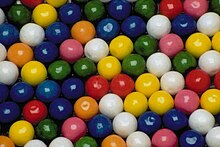Bubble gum
 Woman blowing a bubble | |
| Type | Chewing gum |
|---|---|
| Place of origin | United States |
| Created by | Walter Diemer |
| Invented | 1928 |
Bubble gum (or bubblegum) is a type of chewing gum, designed to be inflated out of the mouth as a bubble.
Composition
In modern chewing gum, if natural rubber such as chicle is used, it must pass several purity and cleanliness tests. However, most modern types of chewing gum use synthetic gum-based materials. These materials allow for longer lasting flavor, a softer texture, and a reduction in tackiness.[1]
Mechanical properties
As a sort of
The linear
Regarding
The stretching experiment shows gum cuds owning
History

In 1928, Walter Diemer, an accountant for the Fleer Chewing Gum Company in Philadelphia, was experimenting with new gum recipes. One recipe, based on a formula for a chewing gum called "Blibber-Blubber", was found to be less sticky than regular chewing gum and stretched more easily. This gum became highly successful and was eventually named by the president of Fleer as Dubble Bubble because of its stretchy texture.
This remained the dominant brand of bubble gum until after WWII, when Bazooka bubble gum entered the market.[5]
Until the 1970s, bubble gum still tended to stick to one's face as a bubble popped. At that time, synthetic bubble gum was introduced, which would almost never stick. The first brands in the US to use these new synthetic gum bases were Hubba Bubba and Bubble Yum.[citation needed]
Bubble gum got its distinctive pink color because the original recipe Diemer worked on produced a dingy gray colored gum, so he added red dye (diluted to pink), as that was the only dye he had on hand at the time.[6]
Flavors
In taste tests, children tend to prefer strawberry and blue raspberry flavors, rejecting more complex flavors, as they say these make them want to swallow the gum rather than continue chewing.[7]
Bubble gum flavor
While there is a bubble gum "flavor" – which various artificial flavorings including
Records
In 1996, Susan Montgomery Williams of Fresno, California, set the
Tourism
Bubblegum Alley is a tourist attraction in downtown San Luis Obispo, California, known for its accumulation of used bubble gum on the walls of an alley.
The
See also
- Functional gum
- Gumball machine
- Gum base
- Gum industry
- Inca Kola
- List of chewing gum brands
References
- ^ "TLC Cooking "What is chewing gum made of?"". Recipes.howstuffworks.com. 1 April 2000. Retrieved 15 November 2012.
- S2CID 97743991.
- ^ ISSN 0148-6055.
- S2CID 224873646.
- ^ "The History of Bubble Gum". ThoughtCo.
- ^ "What was chewing gum originally made from?". madehow.com. 22 April 2007. Retrieved 31 March 2014.
- ^ McGrath, Susan. "Stuck On Bubble Gum". National Geographic World 277. Readers' Guide Full Text Mega (H.W. Wilson).
- ^ "The Strange Recipe Behind 'Bubble Gum Flavor'". Mental Floss. 7 August 2017.
- ^ a b "Bubblegum". Basenotes.
- ^ "How to Make Bubble Gum Flavor Recipe| Bubble Gum Flavor Formula". candyflavor.com.
- Guinness Book of World Records. Archived from the originalon 31 October 2011. Retrieved 2 November 2011.
